Premium Only Content
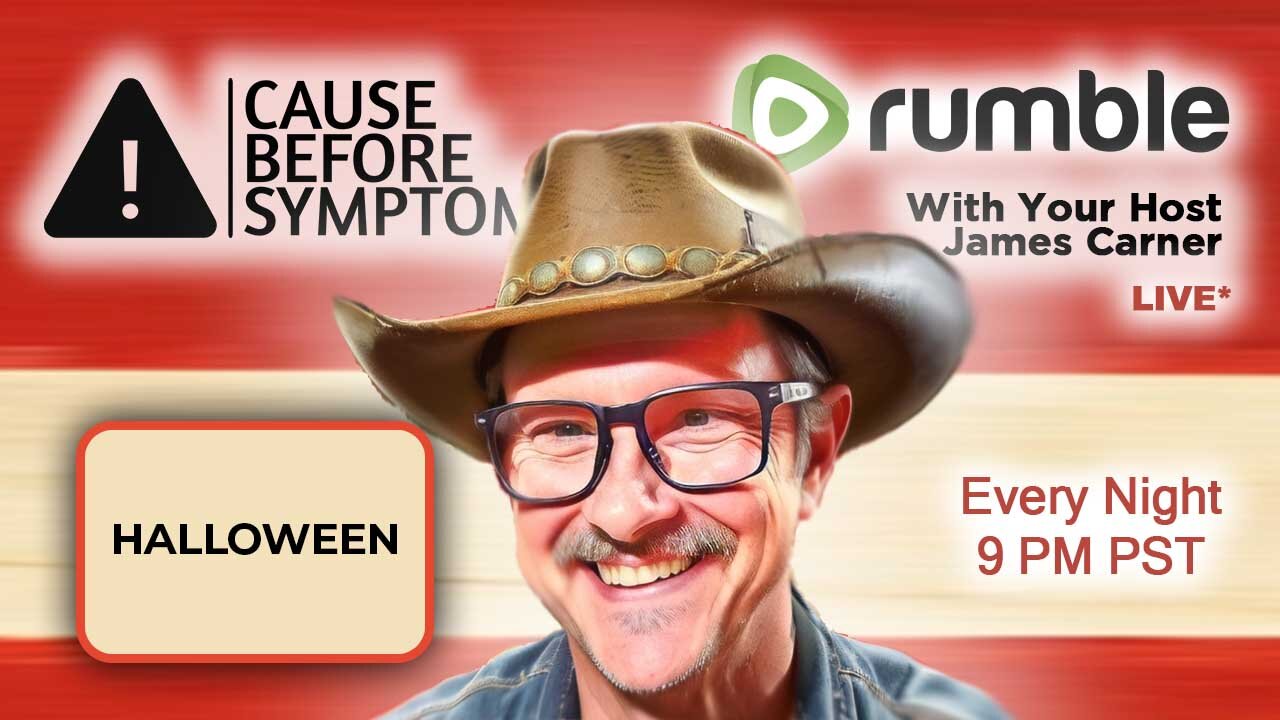
Halloween
Cause Before Symptom - With Your Host James Carner
Halloween
Witches and warlocks prepare 364 days a year for this one day. The reason is the veil that separates the fallen angels and us is less dense on this day. Satan and his horde are lords of the air. This is old English for spirits that exist alongside us but we can’t see them. The dark kingdom uses Halloween to hex, cast spells and curse people. One tiktoker ex-witch said it best. Put your kid in a little mermaid costume and a month later she’s in nightmare sleep paralysis and she’s being monitored by marine spirits.
The candy is hexed with a spell of death upon your family. It’s designed to destroy the temple of the Holy Ghost. Halloween decorations on the home are demonic alters where you inadvertently allow the demonic into your home where you sleep. It’s a literal welcome sign and your guardian angels must stand clear of the rights that the demons have since you partook. Witches and warlocks walk around your neighborhood hexing and casting spells to ward off the angelic and fog your judgement allowing evil to prey on you.
The witches and warlocks are thinking they are doing it for light and love. They think they are warding off evil but it’s the opposite. They are deceived in the highest form. They are opening up energy charging points which was supposed to help them stop evil from their life but they are inadvertently casting spells on us. Yes, you heard that right. The witches and warlocks of the low order are doing Satan’s bidding thinking they are doing good bringing new age spells that are Trojan horses. The witches have no clue that they are harming their neighbors.
Watch this.
Now, let’s get into the origins of Haloween so you are educated on the subject.
The OG Halloween predates Christianity, stretching all the way to an ancient Celtic celebration (and by ancient we mean about 2,000 years ago) known as Samhain (pronounced "sow-in") that took place in what is now Ireland, parts of France, and the United Kingdom. Like most ancient holidays, Samhain marked a transition of seasons, from summer to the beginning of winter, hence the sort of dark and stormy vibes of Halloween today. Participants believed that on the night of October 31, the portal between the realm of the living and the dead opened, allowing lost souls to return to the human-occupied earth.
This ghostly meaning was associated with a few things, from the agricultural (wreaking havoc on crops) to the supernatural (enhancing the clairvoyant capacity of Celtic priests called Druids so they could make predictions and communicate with the dead to facilitate happier, warmer winters). The festivals also typically involved bonfires, at which the attendees wore costumes (yup!) and participated in sacrifices of crops and animals. Afterward, the community would use the bonfire to light their own hearths as a sort of closing ceremony for summer and initiation of winter. So while death and fear were at the heart of Samhain, it had its fun and celebratory side too.
After the Roman Empire conquered much of the Celtic territory in 43 CE, Romans ruled there for some few hundred centuries during which the tradition evolved. There are links to the Roman festival of Feralia, in which the community mourned its dead, and another ceremony called Pomona (named for the Roman goddess and the protector of orchards), in which participants honored fruit and trees.
The Middle Ages
By a few hundred years into Roman reign, the Catholic church was increasingly attempting to replace pagan practices (i.e., indigenous ones) with its own, often while vilifying the former but keeping some of its traditions. (Religion and the Decline of Magic by Keith Thomas is a fascinating read on the topic; for more Halloween history books we love, see Further Reading below.) In the eighth century, when "local people converted to Christianity...the Roman Catholic Church often incorporated modified versions of older religious traditions in order to win converts," as Albany University puts it. As a result, many elements of Samhain persisted. And according to History.com, "the church made November 2nd All Souls' Day, a day to honor the dead" and all saints known and unknown in an attempt to replace the Celtic holiday with a church-sanctioned version of it. Festivities on this day included dressing up as various saints, angels, and the devil. All Saint's Day was also known as "All Hallow's Days," hence the later moniker of All Hallow's Eve.
Sixteenth Century England
In the 1500s, England's King Henry VIII cut ties with the Roman Catholic Church because the pope refused to annul his marriage with Catherine of Aragon, creating the Church of England. As a result, much more tolerance was extended to the Protestant Church for some years, but the Church of England remained mostly Catholic—and became even more so during the reign of Queen Mary I, aka Bloody Mary. She established England's connection to the Roman Catholic Church in part by ordering the execution of 300 Protestants. After her, it was sort of the opposite, as Queen Elizabeth I, was a Protestant. Okay, but what does this have to do with Halloween?, you might be thinking. Well, let's fast forward to the pilgrimage across the Atlantic.
Halloween History in the United States
The Colonial Period (1600s–1700s)
The popularity of Hallow's Eve during the American Colonial era varied from place to place, depending on how devoutly Protestant the communities were. The early colonists were Puritans and fled England because of religious persecution, which is why they were known as Separatists. So, for example, in very Puritanical New England, Hallow's Eve wasn't as widely celebrated, but in the less rigid southern colonies, which were formed more as business ventures than religious communities, the holiday was still observed. During this era, celebrations around the harvest emerged and became associated with Hallow's Eve, likely as a result of the cultural exchanges between indigenous people and Anglo-Saxon settler colonialists. Similar to the way in which the Roman Catholic Church replaced indigenous cultural and religious practices with its own iterations, the same happened here with the settlers and local indigenous populations.
The Early Republic (late 1700s–1800s)
A few generations later, once the U.S. won independence from England and formed a nation, the country saw a huge wave of European immigrants who brought with them new traditions—and media. In 1759, the Scottish poet Robert Burns wrote a poem entitled Halloween, which described some of the holiday's practices at the time and introduced the term we know today. "The word itself seems to be a portmanteau of the word 'Hallow,' which originally meant 'saint,' mixed with 'een,' which was an abbreviation of the word "eve" or night before," according to BigThink.com.
European and American Imperialism
So how did the holiday reach so many different countries around the world? The answer is simple: European imperialism. As with most holidays, Halloween celebrations vary from region to region and different modern iterations of the traditions stem from different ancient cultural practices, but the common thread is the brutality of imperialism and accompanying forced assimilation.
Spanish Imperialism in South America (late 1500s—1900s)
While English Separatists were fighting for independence during the 1600s and 1700s and then later in the Early Republic, they were also establishing a nation in which citizenship was inextricably liked to and defined by one's relationship to land ownership (i.e., you could only be a citizen if you owned land—and you could only own land if you were a white man, hence the power structures we still see today). Similar practices were unfolding in other parts of the continent, except the colonizers were Spanish Catholics.
Even as the Spanish Catholic conquistadores subjugated indigenous people to forced conversion, there were still, of course, traces of local worship and culture, resulting in a fusion of indigenous practices with Catholic holidays. That's why figures like Santa Muerte, which the official Catholic church still refuses to recognize as a part of the canon, persist today. Day of the Dead also falls on the Catholic Holiday All Saints and looks quite different from Americanized Halloween—more on that in a minute.
British Imperialism during the Victorian Era (1800s–1900)
This time period was also one of British expansion and subjugation. Of course, along with colonization came the violent and forced assimilation of other religious practices. As Max Fisher writes in The Washington Post, "the irony is that, while the British were responsible for spreading Halloween, they also spent several decades trying to stamp it out." In the late 19th century, "the strict Victorian social code called for, among other things, a rigid class hierarchy, gender roles that privileged men over women, sexual restraint, an obsession with manners and a deep disdain for all things that might be perceived as indulgent." Halloween, having to do with dressing up, superstitions, and death, was of course one of the many practices that come under fire.
Halloween experienced a resurgence in the UK and its colonies all over the globe (including Hong Kong and Singapore, among many others) after Queen Victoria died in 1901 and social attitudes gradually shifted.
American Imperialism (1900s–Present)
The turn of the century also marked by the rise of U.S. military intervention abroad in countries including the Philippines, Japan, Hawaii, and Iran, where the spread of American cultural practices, traditions, and media was one way to fulfill what scholar Homi K. Bhabha deems "colonial mimicry," meaning peripheral access to dominant American culture. Media, of course, includes all that Halloween stuff. In many of these countries, you'll see local influences fused with the commercialized Anglo-Saxon version of the holiday, emphasizing the pattern of Halloween as both a means of resistance and dominance.
By the time the 1950s rolled around, Halloween was incredibly commercial as more and more industries were able to profit off of it. As Vox reports, confectionaries knew candy would be an easy thing to pass out on Hallow's Eve and predicted that kids would want it (duh), so they increased production, thus increasing affordability and accessibility and ultimately sales, which finally brought about some of (presumably) your favorite Halloween staples, like trick-or-treating and dressing up.
The History of Modern-Day Halloween Motifs
Halloween is a hybrid of mythologies and histories born of both resistance and oppression, joy and mourning, life and death. Its an origin story is befitting of a holiday that celebrates the obscure and occult and the longevity and persistence of folklore, community, and identity.
But where does the Christian aspect of the holiday come into play? In 835, Pope Gregory IV moved the celebration for all the martyrs (later all saints) from May 13 to November 1. The night before became known as All Hallow's Eve. Eventually the name was shortened to the current Halloween.
White Witches
A significant amount of witches celebrate Samhain, a pagan holiday that honors ancestors and spirits, from which modern-day Halloween is thought to have evolved. On this day, it's believed that the veil between the world of the living and the dead thins. "What I believe the media and film tends to confuse about the Samhain holiday is that it's less about being spooked by the dead and more about honoring and venerating those we've lost," explains Blue June, a tarot reader.
There's no one way to honor Samhain. "Traditions vary with witches, as that is part of the allure of being a witch," explains Mysticalcraft Arriana, Keen.com advisor. "Anything goes as long as it has the correct intent, of course."
We asked some practicing witches to tell us what their celebrations usually look like — and it's not as stereotypically spooky as you think.
They connect with ancestors
"I light a candle to honor [ancestors] and leave out candy or libations that they enjoyed," says astrologer Lisa Stardust. She says that unlike Halloween, she's not trying to scare away their spirits, but to honor them.
Some witches speak with these spirits. "An Ouija board is a standard tool to speak with those crossed over," notes Mysticalcraft Arriana. "Mediation and connecting to those in our hearts is another way to connect. Or you can cast a circle and ask for your Deity's help," she says, explaining that each witch has deity they feel close to, that they can reach out to for help and guidance in life.
They give thanks
In addition to connecting with those who have passed, Live The Light, psychic advisor at Keen.com, uses the day to set intentions that help her welcome changes and transformations into her life. "Remember to give thanks for what the summer months brought as you look to the fall ahead. Finally, give a hug and kiss to your loved ones in spirit," she recommends. Live The Light says it's also a good day to eat a favorite food, playing your favorite songs, or share memories with the people you love.
A significant amount of witches celebrate Samhain, a pagan holiday that honors ancestors and spirits, from which modern-day Halloween is thought to have evolved. On this day, it's believed that the veil between the world of the living and the dead thins. "What I believe the media and film tends to confuse about the Samhain holiday is that it's less about being spooked by the dead and more about honoring and venerating those we've lost," explains Blue June, a tarot reader.
There's no one way to honor Samhain. "Traditions vary with witches, as that is part of the allure of being a witch," explains Mysticalcraft Arriana, Keen.com advisor. "Anything goes as long as it has the correct intent, of course."
We asked some practicing witches to tell us what their celebrations usually look like — and it's not as stereotypically spooky as you think.
They connect with ancestors
"I light a candle to honor [ancestors] and leave out candy or libations that they enjoyed," says astrologer Lisa Stardust. She says that unlike Halloween, she's not trying to scare away their spirits, but to honor them.
Some witches speak with these spirits. "An Ouija board is a standard tool to speak with those crossed over," notes Mysticalcraft Arriana. "Mediation and connecting to those in our hearts is another way to connect. Or you can cast a circle and ask for your Deity's help," she says, explaining that each witch has deity they feel close to, that they can reach out to for help and guidance in life.
They give thanks
In addition to connecting with those who have passed, Live The Light, psychic advisor at Keen.com, uses the day to set intentions that help her welcome changes and transformations into her life. "Remember to give thanks for what the summer months brought as you look to the fall ahead. Finally, give a hug and kiss to your loved ones in spirit," she recommends. Live The Light says it's also a good day to eat a favorite food, playing your favorite songs, or share memories with the people you love.
Narayana Montúfar, senior astrologer for Astrology.com, does something similar. "I always perform a ceremony in which I express gratitude for all the things that I have learned in the current year, then I write down all the things I want to let go of, and afterwards, I burn the paper with a lit candle as I imagine them going away from my life," she says.
They meet up with their coven & cast election magick
Usually Sarah Potter, a tarot reader, professional witch, and color magic practitioner based in New York City, meets with her coven in person on Samhain. But this year, they're using Zoom to perform their secretive rituals. ""Our coven does different rituals," she says. "We do magickal work together for the greater good of humanity."
That work feels especially important right now, ahead of the election, Potter says. "I'm very focused on using my magick to ensure that votes are being counted, voting is easier, and the voices that need to be heard are uplifted." She'll also be working on "clearing any obstacles preventing votes from being counted, or anything that would stand in the way of getting Trump out of office." Sounds like a good way to spend the holiday to me.
They donate to black cat funds
... Pretty fitting, right? These are resources that aim to protect black cats, which are less likely to get adopted than other breeds, due to their associations with bad luck. Potter says she's going to look into funds she can donate to this October 31. "I have a black cat and I love her so much," Potter says. "Since I can't do what I would usually do, that was something I thought would feel really nice to do this time of year."
They celebrate it as the new year
Natalie Mills, spiritual mentor, psychic medium, and author of You Are Intuitive, says that she sees Halloween and Samhain as the witch's new year. "For me, it has that energetic quality of a spiritual new year," she says. "It's become a really potent powerful time of connecting to my spirituality, my ancestors, my loved ones, and also for me calling forward the new energy and the future visions for the year ahead."
And sometimes... they work
"I work in entertainment in this facet as well," Blue June notes, "so I'm usually working up to three separate events on the night of Halloween, reading tarot cards. I don't get to partake in the Samhain rituals!" But at least she'll be helping others celebrating their spooky October 31 night.
These are what is considered white witches. They worship love and light. They do not believe there is a devil or demons. They believe it is all organic mother nature spells that are part of the world anyways. This is further from the truth. They are the most deceived of all religions. They are inadvertantly doing the work of Satan.
Every city has a coven. Acutally many covens. Some stick together and some are separate. The covens that actually knowingly worship the devil as true, are nothing compared to the white witch. The witches that cause harm for their benefit or for their coven are interested in power and success. They are your ordinary average business man. Some are freemasons. Witches aren’t always women.
Here’s a good article I read in the Guardian about their practices. It’s from the 90’s but still relevant today.
Witchcraft was outlawed in this country for the best part of a thousand years. But now, officially tolerated and with a new religion of their own, witches are flooding out of the broom closet. Call it magic, call it hocus-pocus, they say anyone can do it ... especially as Hallowe'en approaches. Melanie McGrath reports
According to Cassandra Latham, the rules of spell-casting are: don't dabble but do persist; do not start anything that you can't finish; be aware that anything you wish for in another person may come back to you; and be precise. 'Don't just ask for money, because your nearest and dearest might drop down dead, leaving you an inheritance.'
Candle magic
'A good general-purpose spell that anyone who believes in it can do,' says Latham. Pick a candle of an appropriate colour for the job (green or pink for love, yellow for wealth, red for strength, blue for good fortune, mauve for wisdom, brown for stability). If you wish to draw something towards yourself, write its name from the top of the candle to the bottom. If it's something you want to dispel, write it from the bottom to the top. Candle magic, like most magic, is best done after dark. To draw something to you, begin the spell on a new moon; to dispel it, begin on a waning moon. Light the candle and strongly visualise what you want to achieve for as long as you can maintain concentration. Blow out the candle. Repeat the procedure the next night, and again each night until the moon has completed its waxing or waning. Bury or burn the candle debris. Don't throw it away. Don't talk about the spell; and, once it's done, forget about it.
Witches' ladder
Dedicate a piece of rope to magic. Following the same lunar pattern as for candle magic, each night tie one knot in the rope while strongly visualising what you wish to achieve. Tie the knots towards you to draw your object inward and away from you to dispel it. Witches' ladders have a long tradition in Cornwall, where they were commonly sold to fishermen before a trip out to sea. Untying the first knot would unleash a light breeze, the second a stronger wind and so on. A witches' ladder also refers to a string of 40 beads used like a rosary as an aid to concentrated repetition.
Witches' poppets
Poppets are wax, clay or even Plasticene figures resembling the person on whom the magic is to be focused. In a coven, the poppet may be consecrated on a witches' altar, attached by cord to both a woman and a man (according to the Wiccan belief, that male and female energy combined create the most effective magic), and given the appropriate symbolic treatment. The poppet's leg might be bandaged as part of a healing ritual, or its mouth might be sewn up to prevent the living person it represents from spreading gossip. Once the spell has worked, the poppet will be burned or buried, thereby releasing the spell.
When I was a little girl, I thought I was a witch. Borrowing my mum's old milkpan, I would pass balmy summer evenings stirring livid stews of wild berries and gladioli over a bonfire at the back of our garden, then pour the resulting brew into jam jars and label them "potion". I communicated with other (invisible) witches in witch language scrawled over my cupboard door. I made up witch songs and caterwauled them out of the window at night. I began demanding to be persecuted. My particular hankering was to be tossed into a chasm, though these are not at all common around Basildon. To my mother and father's credit, they resisted what must by then have been the almost irresistible, and I lived on. Not content with my good luck, I acquired a black cat. Finally, and to my eternal regret, I fed my hamster to a toad.
Some time soon after, I discovered Fuzzy Felt, or perhaps it was Pippa dolls, and forgot all about witchcraft. Until a couple of years ago, that is, when The Old Religion, as witches often call it, suddenly emerged from the broom closet and into the light. The Craft and The Blair Witch Project appeared on film, The Witches Of Eastwick went into production as a musical. The first of the Harry Potter books was published and sold in its millions. Sabrina The Teenage Witch and Buffy The Vampire Slayer began airing on British TV. All over Britain (and America and beyond), Hecate was getting hip. Something curious was happening.
It got curiouser and curiouser. During my research for this article, I found a tarantula on my doorstep. Sometime later, a live crow in a knotted dustbin bag appeared (and flew to its freedom the moment I opened the bag). Now, crows and tarantulas don't wash up on my doorstep every day, but life is plump with coincidence, weirdness happens, and though intrigued and slightly ruffled I carried on all the same.
According to the Pagan Federation, there are currently 10,000 initiated witches in this country and more than 100,000 pagans. Compare this with 6,000 practising British Druids and 4,000 Buddhists, and you'll get the point. What was once taboo is now almost de rigueur. The witch religion, Wicca (wicce is the Anglo-Saxon word for witch), though only founded within the past 50 years, is growing fast. And we're exporting it. In the past couple of years, Wicca has really taken off on the continent and in the English-speaking world, most particularly in the US and Australia. No one knows how many Wiccans or witches there are worldwide, but a million would probably cover it. And it all began here in Britain.
Some definitions are called for. Wicca is a subset of paganism, as well as being the witch religion, and while all Wiccans are witches (even the men), not all witches are Wiccans. Some witches are agnostics, or Christians, or Hindus, or just plain old witches. The latter are often known as hedge witches. They tend to work alone and often describe themselves as being in The Craft. Most Wiccans, by contrast, work in covens. It goes without saying that not all pagans are witches, nor, necessarily, are all witches pagans. Wizards and warlocks, by the way, are neither witches nor Wiccans, but people (usually men) who practise high magic (more of which later) with no overtly religious context. So far as we know, there aren't many of them.
To make it all crystal clear, let's just say that The Witches Of Eastwick are Wiccans, Sabrina is a hedge witch and, if Harry Potter is anything, then he is probably a wizard. Paganism and witchcraft have been a thriving part of British culture for as long as there are records. In the 11th century, King Canute was sufficiently threatened by them to issue anti-pagan and anti-witchcraft laws, and witchcraft was still illegal in this country until 1951. But The Craft was relatively tolerated in England. Elizabeth I had her own court witch in the form of John Dee, the royal alchemist, and even during the great witch-hunts of the 16th and 17th centuries, witches were rarely burned alive in England, as they were in continental Europe and Scotland. They were hanged or strangled, then burned.
Having lain low for a century or so after those particular horrors, British witches began to re-emerge in the 18th century, in the guise of cunning men and wise women, local oddballs who lived on the outskirts of villages and ministered to broken hearts and neighbourhood grievances.
Cassandra Latham still does. Britain's only professional witch (her tax return states her occupation as "village witch"), Latham whips up charms and spells for the locals of St Buryan, near Land's End, and, via her website, for anyone else prepared to stump up a modest fee or offer a skill to trade. Latham even looks the part - a tiny, impish thing with sky-blue eyes and witchy, black hair, chopped, rather charmingly, mullet-style. A qualified nurse and counsellor, Latham turned to witching 16 years ago, after a back injury put paid to her nursing career, but she always knew she was different: "I didn't have a wonderful childhood and I retreated into otherworldliness. Part of the work I do now involves walking between this world and the spirit world, and I did that, too, when I was a child. It used to be an escape route, now it's a choice."
Glaswegian pensioner Mary Rands inherited her interest in witchcraft from her grandmother, who was considered "fey". Rands' sister is also a witch. "I chose witchcraft, but witchcraft also chose me," she says. Most witches have no family connections to The Craft, but feel drawn nonetheless. Maureen Brown is a qualified Jungian psychotherapist, who has been a member of a coven in Croydon for the past 26 years. "As a child, I was considered strange because I saw things with lights around them, which I now know to be auras. I was always different. I was always a seeker." In her early 20s, Brown was introduced to two witches at a party and never looked back. "By that time, I had experimented with many of the major religions, but I just knew that witchcraft was for me."
Caroline Robertson, proprietor of Westbury Music, the UK's leading independent dance-music label, was initiated into Wicca four years ago, but her interest in witchcraft began in childhood. "I was always a daydreamer. I believed in the force and power of nature and in the mystery of life." She bought her first pack of tarot cards at university. "It was 1970, Lennon and McCartney were doing their thing and everyone was getting a bit mystical." According to Robertson, you don't have to be born a witch, but it takes a certain kind of person to become one. "A businessman's mind would be wasted in a coven. Witchcraft is about threshold worlds and shifting realities. It appeals to odd people, loners, folk who don't follow the normal rules."
Cassandra Latham doesn't follow "the normal rules", but her clients - she sees about 200 a year - tend to be regular Joes and Joannas with all the usual problems. "The reasons people used to go to cunning folk in the past are the same as the reasons people come to me now. Relationships, jobs, money, health. People often ask me to cleanse their homes of psychic debris. One of the most common things I get asked to do is to remove curses, but no one ever asks me for anything ridiculous. It's pastoral work, just like the vicar, really."
Well, not quite like the vicar (though Latham says she gets on well with him). "What makes me different from a psychotherapist or any other counsellor is that I use magic. I believe that old habit patterns lie in the unconscious. If you want to change them, you need to communicate to the unconscious in a way it'll respond to - with symbols and archetypes and ritual. If you perform a spell with particular motifs, it will clear the unconscious ground. I find it very effective and very quick. You could spend years in psychotherapy getting to that point, whereas magic will take the shortest route, and in it goes."
Ah yes, magic. It's nonsense, obviously. Well, perhaps not complete nonsense. But definitely something for the funny folk. Except, except ... we all do it. Every time we step over cracks in the pavement, don our lucky ties for the job interview, spit on the dice before we throw, we have fallen under magic's spell. Vivianne Crowley, senior lecturer in the psychology of religion at London University, puts it like this: "Magical thinking gives us a sense of control in a world of random events. It gives you a sense that the universe is listening to you and speaking to you. Psychologically, that can be a very useful strategy." Children employ magical thinking every day and the world religions all have some magical element. What else are biblical miracles or the mysticism of the Jewish cabbala? However much we may pooh-pooh magic, we seem to be saturated in it all the same. "Magic connects with people on some ancient level," says Latham. "It's like a race memory almost. It hits the primitive part of our minds."
Crowley agrees: "Most witches believe that magic is innate in the human psyche. It's something lots of people can develop." She's not talking about sawing ladies in half or card tricks. She's talking about actual, transformative magic.
But what is magic? Well, no one really knows, but received wisdom defines it as the use of the will to effect change, and recognises two types: natural and high, or ritualistic. In natural magic, witches emphasise folk wisdom. They may cast spells and use candles, herbs, wax images, crystals and scrying or divination objects such as crystal balls and dowsing rods, as well as more familiar psychological techniques such as meditation, visualisation and repetition to focus their minds on the effects they want to manifest. Natural magic is craftwork, and its practitioners regard themselves as craftsmen and women. They are in The Craft.
High or ritualistic magic tends to focus more on ceremony, ritual and invocation. Alchemists were generally high magicians, but high magic's most famous son is probably the turn-of-the-century mystic and occultist Aleister Crowley. Most ritualistic magic is conducted in groups or covens. Witchcraft's own religion, Wicca, makes much use of it. "The difference," says Latham, "is that high magic is formal and theatrical."
Does magic work? Graham King thinks so. Four years ago, King sold his successful business making specialist cameras for archive libraries, got rid of the Jag and the country cottage, burned his collection of silk ties and bought the Museum Of Witchcraft, Boscastle, on the north coast of Cornwall, which he now runs as a going concern. Fifty thousand visitors come to the museum every year to peer at the cases of charms, amulets, poppets (wax dolls), wands, athames (ceremonial knives), scourges (ceremonial whips) and talismans. Having spent 20years as a scientist, technician and businessman, King now devotes his life to witchery. "I'm a scientist, but I believe in magic because I've seen it work," he says. "I don't know why it works, but I accept it does. Look, I have been employed in the electronics industry, and I don't know how electricity really works, either, but it does, right?" He has a point. Hands up who really understands how the telly makes pictures, or the microwave makes dinners. As for the VCR . . .
Debate as to whether magic is a psychological or supernatural power, or a bit of both, boils like a brothy cauldron in the witching community. Vivianne Crowley (no relation to Aleister, incidentally) is in no doubt. "The power of magic is 90% psychological and 10% anomalous events not beyond scientific understanding but beyond current scientific understanding. Even the British Psychological Society has become interested in the ability of spiritual practices to manifest healing powers, and in clairvoyance, psychometry [the ability to divine by touching something] and telepathy, those techniques psychologists call parapsychology." She points out that there is now a chair of parapsychology at Edinburgh University, it's that respectable.
According to Crowley, Wiccans simply harness and develop these parapsychological techniques. Which is both disappointing (no fabulous supernatural phenomena) and intriguing (anyone can do it). "Could I turn a lightbulb into a frog?" asks Maureen Brown. "Yes, but it would take a very long time, and all my energy, and it's easier to work for the money and then go and buy a frog." Caroline Robertson agrees: "I could probably change plastic to gold, but it would take years." Crowley is sceptical. When I told her that some witches claimed to be able to turn lightbulbs into frogs, she just laughed and said, "Rubbish!"
The obvious question remains. If magic is as powerful as some witches claim it to be, why can't witches put a stop to famine/war/ disease? And why isn't every witch a millionaire? Or immortal? Ah, well. For one thing, witches are human, as fallible as doctors or politicians (and we all know how fallible they are). Most witches just aren't all that competent, and the ones who are tend not to mouth off about it. Not so long ago, a very public attempt by the self-proclaimed king of the witches, Kevin Carlyon, to prevent the building of the Channel Tunnel by burning an effigy of a train raised a good few nudge-nudge, wink-winks in the pubs around Lewes, East Sussex, Carlyon's home town, and knocked something of a dent in the reputation of The Craft. These days, most witches have learned to be more modest about their powers. "I'm not Superwitch. I would say that I have a 70% success rate," says Latham, "but I can't think of any business which is 100% all the time."
Then there's the responsibility. "If people think I'm going to wave a magic wand and whisk their problems away, they have to think again," says Latham. "I can help you to help yourself is all. If I waved a wand, I'd just be disempowering you." If that sounds a bit like self-help waffle, witches insist they get results. King recently cast spells for a couple who were finding it hard to conceive, and "baby Sean arrived nine months later". On the other hand, "I only get involved with things where there's real need. Someone who just wants a new boyfriend can sort themselves out."
What about black magic? Officially, Wicca operates a no-harm principle, the so-called Wiccan Rede, but King claims that "the principle is recent and not many witches stick to it". King himself admits to having cast spells with "broken mirrors and effigies and coffins to warn people to behave well. The circumstances haven't yet arisen where I might actually curse someone, but that's not to say there are no such circumstances."
Rands isn't so circumspect. In the 30-odd years she's been a witch (and a civil servant, qualified nurse, nanny), she's found herself in the hexing business twice. "Oh, I've stamped my foot and pointed my finger all right. I'm old-fashioned in that way. An eye for an eye. I cursed one man who was forcing his sexual attentions on women and he's now got a very nasty incurable skin disease. That might not have been my doing, of course, it might have happened anyway. But..."
That said, most witches hesitate to use black magic because they believe in the threefold boomerang - that their actions will return to them three times over. Since sending her victim a skin disease, Rands' own health has taken a downturn. "If that's because I've ill-wished someone, then I have to take responsibility." Then she chuckles. "But it was worth it."
Cursing and hexing are partly what gives witchcraft a bad name, of course. But even if black magic were effective, in the context of the damage done in the name of the world religions, a little skin disease among roués doesn't seem so bad. All the same, there's a reluctance among many witches to talk freely. You can hardly blame them for having a persecution complex. Somewhere in the region of 40,000, mostly women, were murdered in Britain during the great witch-hunts, for an assortment of evils ranging from spinsterhood and warts to ergot poisoning. (Ergot is a fungus that infects rye, causing convulsions and hallucinations in anyone who eats it. There is now plenty of evidence to suggest that the symptoms of the "possessions" at Salem and elsewhere - in the UK in East Anglia especially - during the witch-hunt period were the result of ergot poisoning.)
Even now, in our secular age, we can't quite make up our minds about The Craft. Though the Witchcraft Act was repealed in 1951, we're still edgy about witching. Lest we forget, it was only 15 years ago that we had our own Salem, with the tabloids screaming blue murder over supposed acts of satanic abuse by witches and Devil worshippers. Even though a 1994 government enquiry into the whole affair found that ritual abuse "has never been substantiated by empirical evidence", the public remains willing to lump witchcraft in with Satanism, as though the two were some devilish double act. (For the record, witches do not believe in the existence of Satan, so it would be a little eccentric of them to worship him/her/it.)
Earlier this year, evidence of ritual activity was discovered on the hills overlooking the Meon Valley, near Southampton. Wax had been dripped on to the ground from candles and, buried in a circle, investigators uncovered 12 dead rats. Meon Valley police immediately contacted Graham King at the Museum Of Witchcraft for advice. Inspector Shaun Moore of Meon Valley police says: "We are concerned it might lead to something." The headline in the Southern Daily Echo (and it was a big one) read, "Occult Probe". Shock and horror! Wax drips and dead rats.
Discrimination against Wiccans and pagans is alive and well, tinged with ignorance and paranoia. Drama teacher Ralph Morse was recently suspended from his job at Shenfield high school in Essex after admitting to being youth officer for the Pagan Federation and a practising witch (he was later reinstated). The school's headteacher, John Fairhurst, issued a statement saying, "We completely and unequivocally reject their world of witchcraft and magic." Rands was asked to leave her post as a nanny after her journalist employer accused her of using witchcraft to "steal the children".
In the US, things are even worse. Despite a constitutional guarantee of freedom of speech and religion, Harry Potter (our own dear HP!) is banned in schools in Kansas and Colorado for promoting witchcraft. (The rows of chain stores and discount outlets piled high with pointy Hallowe'en hats and broomsticks are okay, though. That's just business.)
Thankfully, witches appear not to have returned the religious bigotry. Having made the journey from Catholic to witch, Rands insists, "there's not much distance between them. They share the same sense of ritual." Graham King goes further: "I would have no trouble invoking Christ. I would visualise him and ask for his assistance. I don't think he's the son of God, but he's a pretty good witch."
The next decade could see Wicca completely throw off its associations with the occult ("occult" means hidden) and go mainstream. Which would no doubt please its founder, Gerald Gardner (1883-1964). Claiming to have been initiated in the "Old Ways" by a crone named Dorothy Clutterbuck in the New Forest in 1939, Gardner published Witchcraft Today soon after the repeal of the Witchcraft Act in 1951 and effectively founded what has become Wicca, the witches' religion. In Witchcraft Today, Gardner laid out the eight sabbats, or Wiccan festivals, an amalgam of the old pagan solstices and equinoxes and the Celtic nature festivals of Imbolc (Candlemas), Beltane (May Day), Lammas (beginning of August) and Samhain (All Hallow's Eve).
A mildly eccentric ex-colonial civil servant whose influences ranged from Hinduism to folk magic to freemasonry, Gardner conceived of a celebratory religion whose focus was on the power of the natural world. Wiccan rituals generally begin with the drawing of a magic circle, offerings to the elements and the four directions, and continue with a series of rituals, incantations and chants whose power rests in the symbolic marriage of male and female. But does that amount to a religion? Vivianne Crowley says it does: "A religion is a set of ritual acts and practices invoking or calling up the divine. By that definition, Wicca is undoubtedly a religion."
One problem with Gardner's work, however, was that, in order to give Wicca the authority he felt it deserved, he couched its rituals and incantations in purple prose, stuffing in grandiose archaisms wherever he could fit them, so that, to the unconvinced, Wicca can seem rather absurd, all thees and thous and thereforeuntos. Even the Wiccan salutation - Blessed Be - is tinged with hey-nonny-no.
Another problem is that Gardner appears to have been a bit of a perv. It was he who introduced into Wiccan ritual scourging, the practice of using flails or whips lightly to scourge the skin as an aid to concentration. This idea was not new - some Hindu and Christian sects still practise it - but there was no evidence that it had ever been part of witchcraft traditions. And his ideas about working "skyclad" or naked also raised some eyebrows. "Yes, Gardner probably was a dirty old man and virtually illiterate and, no, there is no evidence for scourges elsewhere in any witchcraft literature," admits Graham King.
Neither of these things appears to have put Wiccans off. "Wicca is a surprisingly modern religion that draws on some ancient ideas," insists Crowley. "Wicca venerates nature, and is associated with vegetarianism and animal rights. Its feminism and emphasis on individual responsibility matches people's perception of the world."
But, I say, nudity, magic, the mysteries of nature, it's all a bit un-British, isn't it? On the contrary, says Ronald Hutton, professor of history at Bristol University. "Wicca is very British - English, actually. We are the first nation to have industrialised and to have been acutely cut off from the natural world. Wicca is a response to that, a countercultural religion allowing people to link back with the land."
A product of our history it may be, but does Wicca have a future? Since its inception 50 years ago, it has branched off and taken on local flavours. There are now radical feminist, gay and all-male Wiccan groups. "Wicca is going through radical changes at the moment because of its growth," says Crowley. "There's a much wider range of people now, and a lot of those getting involved are not seeking the occult but a modern spiritual practice. They're attracted to participatory ritual, and there's a hunger for a spiritual system that enhances lives by bringing about an inner change. And Wicca is celebratory."
Wiccans themselves are optimistic. As Crowley says, "Wicca has no paid leadership, no buildings, no capital: it's like a huge voluntary group, but it's survived 50 years." Professor Hutton, himself a druid, agrees: "The fact that Wicca is a mystery religion and includes nudity and initiation rites means it will always shock the mainstream, but I think it will persist. Wicca is having a strong influence on rave and rock culture, eco-pagans and road protesters. The correspondence between magic and virtual reality means it also appeals to infotech workers. It's a religion for self-employed and self-reliant people, artisans and individualists, and it is currently finding its role as the clergy or inner ring to these groups. The 90s saw a remarkable pulling together of all the pagan strands."
No one I spoke to had any ideas about the tarantula and the crow, by the way. The woman in my local pet shop wasn't missing a tarantula, though she pointed out that they are great escape artists. So I've decided the tarantula was a runaway pet. But as for the crow, well, I really don't know what to think about the crow.
Black Witches
They curse and hex their enemies. Usually the victim is a business competitor or someone who attends social events that the warlock or witch is jealous of. They gather a peice of their body or something that eblongs to them and place the object in a bottle along with a hex letter. This object is buried or throw into the water. Many times the spell jar is placed somewhere on their enemy’s property. Their letter is usually written intent of manifestation. Something they want to happen. Depending on the spell or ritual difficulty, the better it works long term. These can also be a hex on a city or county with intent of manifesting their desire. For voting, justice or financial gain. These objects are placed and hidden near or around the property of the capital building. Doing such work is best in Halloween due to the thinning veil where demons and watchers have more power.
The witches and warlocks kidnap and ritualize an innocent. This is a sacrifice that is required in many rituals and spells. In order for their spells to work they must give blood for blood. Halloween week is the biggest week of the year for kidnapping. Statistically vilent crime spikes 50% from 7pm to 1am on Halloween and that is what is reported. Underground in every city, there is a secret sacrifice chamber that the covens use where no one can hear the victim scream. They could be under courthouses, schools, businesses or under parks. These secret tunnels are a well guarded secret. Death happens to any who share the secret and then it is quickly buried. Some covens kidnap and place people underground all year for a great sacrifice on hallows eve. These rituals are paramount for power and success of the coven.
Walking hexes where the witch or warlock walks around a neighborhood, mainly their own, where they hex each neighbor for favor of themselves and covet matters. These hexes are love spells, death wishes and anything you can think of that manipulates the unwilling neighbor. They conceal their deed by simply walking a dog and whispering as they walk by. Christian homes that are anointed with oil are usually protected if the head of the house is godly and keeps the commandments.
Resources are gathered in one big spot where a ritual is performed over the resources. For example, a sugar manufacturer on halloween will place a ritual spell on all of the resources they have brought in all year for death wishes on whoever consumes it. Or a clothing company will do a ritual around all their merchandise to enact a spell of want where people will be influences by demons to buy their products. Ever wonder why you have a room full of junk? You buy these things because the ritual performed over it sends demons to you. If you left a hole somewhere through sin, the demons can convince you to buy the useless product.
Domesticated animals that are missing in cities are usually captured for sacrifice purposes. If your pet is missing, many times it was captured by a witch to sacrifice it as a hex on you and your family. Sometimes they save the animal all year until Halloween to make sure their spell works. This means the witch looks after and cares for the pet until tonight.
Canibalism is poracticed as the witches and warlocks eat the bodies of those that were kidnapped. This practice gives them the DNA and spirit of the family that they kidnapped to capture their spirit energy. They use this to manipulate and play around with the victim’s family for sport or curiosity. The family is plagued with disease, death and poverty and never can get a break. Usually, this is due to a witch or warlock spell where it creates a generational curse as the witch gains wealth from their misery for centuries until the curse is broken.
Orgies and sex magick is practiced on this night because of the thinning veil. Sex magic is by far the most powerful magic to exist which they also perform abortions on themselves while pracicing lude and immoral sexual acts. This is to pay homage to the light bearer and offer the power of lust over them. People will be attracted to them and they could be uglier than a sack of potatoes. The orgies can be simple to extravagant depending on the spell and intent of the ritual. Animals are introduced at times practicing beastuality.
Sometimes, all of the above is practiced all at once on Halloween. The most vile and lude acts of immorality to anger god and give them. Here is a small list of the most common spells they practice:
* Commmanding
* Depending upon the size of a spell, some witches are able to cast magic by simply willing for something to happen.
* Defensive
* Multiple spells that are able to defend the attack of a witch.
* Deviltry
* Multiple spells that deal with the influence of Demons.
* Demonic Exorcism
* Able to break the influence of a Demonic Possession.
* Freedom Spell
* Able to unleash Demons from a mystical prison.
* Freedom Reversal Spell
* Able to reverse the effects of a Freedom Spell.
* Suppression Sigil Spell
* Able to suppress the actions and powers of a Demon.
* Suppression Sigil Reversal Spell
* Able to reverse the effects of a Suppression Sigil Spell.
* Demon Resurrection Spell
* To Bring Out Demons From Someone
* This spell draws the Demons from the possessed and into the spellcaster.
* Elemental Spells
* Spells that effect the elements of nature.
* Water Levitation Spell
* Able to suspend water droplets in mid-air.
* Fire Spells
* Multiple spells that are able to create and/or extinguish fires and/or heat.
* To Light A Candle
* To Extinguish Fire
* To Conjure Heat
* To Super Heat An Object
* To Summon Flames And Keep Foes Away
* To Set A Fire
* To Control Fire And Use It To Kill Enemies
* Locator Spells
* Crystal Locator Spell
* Blood Tracking Spell
* Book of Shadows Tracking Spell
* Unlocking Spell
* Electrical Surge Spell
* Change the Color of Clothes Spell
* Animation Spell:
* Will animate an inanimate object to make it move or appear as if it were alive.
* Resurrection Spell
* Memory Spell
* Expanding Lungs:
* Put your hands on the witch or human that is choking.
* Conjuration of The Lemon and Pins:
* This spell is used to see if the witch that has cast this spell has good or bad luck.
* To Bind Magic to the Balcoin Medallion
* Witches have to form a circle around the fire and hold hands. Then they have to focus on the fire, breathe deeply and slowly.
* Hypnosis Spell:
* This spell was used by the Witch Hunter Eben to kill John Blackwell by bewitching Cassie Blake. The caster must drop liquified linden root into the eyes and mouth of the victim.
* Hypnosis Reversal Spell
* Used to reverse a hypnosis spell. Brings back the will of someone that has been hypnotized or bewitched.
* To Show Hidden Things
* A Spell For Invoking Dark power To Kill Witches
* This spell kills all witches without Balcoin Blood. By burning them from the inside out.
* Protection spell
* For an Untrue Lover
* A Tree/Apple Spell to Find and Bring Someone to You
* To Hold Evil Harmless
* A Talisman for Strength
* To Cast Out Fear and Malignant Emotion
* Divination Rituals to discover a lover
* To conjure a gorgeous delivery man
Witches cast spells to cause harm or misfortune to others through ritual acts. The belief is that spells are effective because of "sympathetic magic," which is the idea that performing an action on one object will impact another object that shares a commonality with it.
Here are some other beliefs about witches and witchcraft:
* Witches can access a person's bodily waste, hair, or nail clippings to harm them.
* In parts of Europe, witches can curse a person by making a doll or effigy of them and inserting pins into it.
* Witches acquire their powers through initiation or inheritance.
* Witchcraft is immoral and involves communion with evil beings.
* Witchcraft can be thwarted through intimidation, persuasion, defensive magic, or physical punishment.
* Some Indigenous peoples in Africa and Melanesia believe witches have an evil spirit or substance in their bodies that drives them to cause harm.
* In the pagan community, there is a belief that whatever you do to others will come back to you.
In conclusion
There is no good witch or bad witch as all witches are practicing Satanism. Anton Lavay, the founder of the Church of Satan said it best. LaVey believed that the distinction between white and black magic was a result of "smug hypocrisy and self-deceit". He believed that magic is magic, regardless of whether it is used for good or evil. I can hear the protests now. “It’s just an innocent fun night”. “There is nothing wrong with dressing up and getting candy”. “When my family participates in Halloween, we are not doing the wicked, evil, and occultic things. We are just having fun”. On and on the excuses go. There is nothing innocent about Halloween. Even Anton LaVey has been quoted as saying, “I am glad that Christian parents let their children worship the devil at least one night out of the year. Welcome to Halloween.” I concede that there is nothing inherently wrong with kids dressing up, provided that the costumes are not evil in nature or kind, and there is nothing wrong with getting and eating candy. But how do you know if the sigils are vexed? However, when you do these things in connection with Halloween, it is wrong because you are participating in an event that is evil in intent and nature. If you want to dress your kid up as a doctor and give him a candy bar, by all means, do it. Just do it on November 20th, or February 10th, or some other day. Just don’t do it on Halloween. If you cannot do that, then your issue is you secretly like Halloween and you want to give in to your flesh and participate in this day.
Sources
https://www.tiktok.com/t/ZTFt58xA3/
https://www.housebeautiful.com/lifestyle/a32933762/history-of-halloween/
https://www.refinery29.com/en-us/2020/10/10138231/real-witch-halloween
https://www.amazon.com/Complete-Book-Black-Magic-Witchcraft/dp/B08CM69346/ref=asc_df_B08CM69346/?tag=hyprod-20&linkCode=df0&hvadid=693298593102&hvpos=&hvnetw=g&hvrand=12624443479480305297&hvpone=&hvptwo=&hvqmt=&hvdev=c&hvdvcmdl=&hvlocint=&hvlocphy=9194587&hvtargid=pla-930297973104&psc=1&mcid=34140fa5489637739abb1ac74ef77a9c
https://thesecretcircle.fandom.com/wiki/Spells_and_Rituals
https://www.theguardian.com/theguardian/2000/oct/28/weekend7.weekend3
https://www.colliervillegracechapel.org/post/thoughts-on-halloween
-
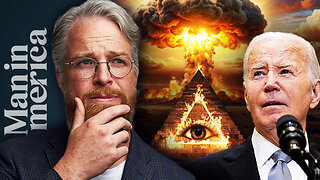 59:31
59:31
Man in America
15 hours agoEven WW3 Can't Stop What's Coming—the Cabal is COLLAPSING w/ Todd Callender
102K72 -
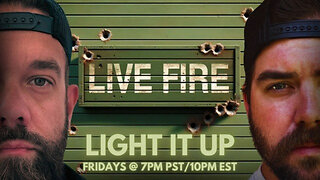 3:51:28
3:51:28
I_Came_With_Fire_Podcast
15 hours agoSPECIAL LIVE FIRE w/ Bearded Viking Mead Co
81.5K9 -
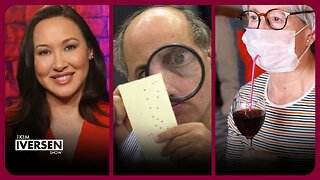 1:28:52
1:28:52
Kim Iversen
13 hours agoUnmasking the Truth: Most Censored Historian On Past Election Meddling, COVID, and Trump
78.3K69 -
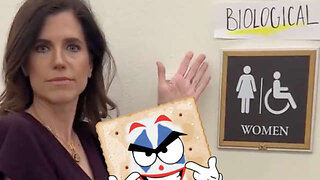 2:10:00
2:10:00
TheSaltyCracker
11 hours agoNow Lefties Lose Bathroom War ReeEEeE Stream 11-20-24
148K368 -
 1:03:31
1:03:31
Fresh and Fit
13 hours agoWhy Men Need Options To Avoid Falling For This!
119K14 -
 1:26:56
1:26:56
Flyover Conservatives
1 day agoWar Raging, Bank Closing, and Humanoid Robots: It’s Biblical! - Clay Clark | FOC Show
55.8K14 -
 5:32:27
5:32:27
tacetmort3m
1 day ago🔴 LIVE - MY MOST ANTICIPATED GAME IS OUT - STALKER 2 LAUNCH DAY
29.1K -
 1:05:16
1:05:16
Glenn Greenwald
15 hours agoBiden Again Isolates The U.S. To Protect Israel; Will The Trump Admin Be Any Different On Israel? U.S. To Send Ukraine Civilian-Killing Landmines | SYSTEM UPDATE #369
104K94 -
 2:21:27
2:21:27
WeAreChange
14 hours agoPSYOPS Launched To Sabotage Trump's Cabinet! MAGA Fights Back!
63.7K11 -
 1:25:02
1:25:02
The Officer Tatum
14 hours agoLIVE The View FORCED To Apologize, Laken Riley Verdict, Nancy Mace and MORE OT Show EP 12
76.8K190